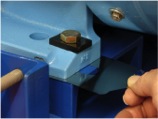Jacking bolts provide a smoother, easier way of moving machinery than using pry bars and hammers. Their use will almost always speed up the alignment process, prevent excessive minor moves back and forth, and generally make the task of shaft alignment much more pleasant.
So why aren’t they used more often?
- Expense? Four pieces of threaded rod or bolts, with nuts welded to the base plate, make excellent jacking bolts.
- Installation? Tack weld the nut to the base, and you’re done!
- Too far from the jacking bolt to the motor? Use a spacer.
- Can’t weld in that area? Drill and tap a metal block, and then drill and tap into the base. Bolt the block to the base. Or use a couple of bar clamps, like you may already have in the welding shop. Reverse the moveable jaw, and slide it under the motor.
- Can’t do that either? Jacking bolt accessories are available from several companies, including VibrAlign!
- Don’t have time? The time installing jacking bolts can usually be faster than the time chasing a motor back and forth with a dead blow hammer, not to mention repainting all the paint you beat off the motor.
Here’s a few jacking bolt tips:
After the alignment is completed, back them off. Leaving the jacking bolts on the motor tend to bind the feet, increasing the chances of soft foot, as well as the chance of warping the motor frame, and increasing vibration.
When moving a machine horizontally, turn the bolt head one flat, and notice the amount of change. This should giveyou an estimation of how many “flats” you need to turn to get the motor into the correct position
Use the jacking bolt you are moving toward as a stop. Set the “gap” amount of movement with a shim or feeler gauge, and then “push” the motor with the opposing jacking bolt until it touches the jacking bolt you “gapped”. This will usually get you very close.
and then “push” the motor with the opposing jacking bolt until it touches the jacking bolt you “gapped”. This will usually get you very close.




